High Poly and Low Poly 3D Models Difference
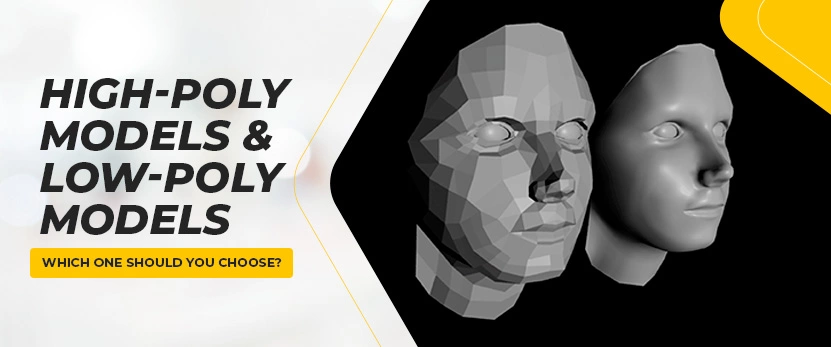
3D modeling has become the most essential tool for many businesses, including eCommerce, real estate, and many more. The reason is simple, creating 3D models helps businesses showcase their products or services in a new way that not only attracts the buyers but also helps the businesses reach a new level in terms of branding.
3D modeling consists of various techniques using which real-looking images are created. Today we are discussing two such techniques, namely, ‘High Poly’ & ‘Low Poly’ 3D modeling, and will try to extract the difference between the two.
But before we start, it is important to get the basics. Keep scrolling.
What is a high poly 3D model?
High poly refers to the usage of more than 100,000 polygons based on the type, size, and complex level of the model to create a mesh. High poly 3D models are hyper-detailed and ultra-realistic 3D replicas of real-world objects. Highly poly means having a high polygon count and complex geometry, which makes a 3D model so realistic. Owing to their high levels of detailing, high polygon 3D models are mostly used for depicting intricate details like design elements, lifestyle images, silo renders, animations with zoom effects, etc.
Talking about high poly in 3D modeling, when the poly count is higher and the weight of the 3D model becomes heavier, we can conclude that it is because of the use of high polygons.
Application of High Poly Models
High-poly objects facilitate photorealistic representations, and users can zoom in to take a deeper look into the features. Here are the key uses:
- You can use high-poly rendering to showcase any object that can be segregated into cross-sections.
- You can deploy high poly 3D rendering to develop renders of homes, engineering materials.
- If you need to showcase your products using images of the highest definition, then high-poly modeling should be your choice.
- You can use high poly models to engage your target audience and to showcase the detailing of your product.
- High poly models should be your option if you are looking for visual richness and accuracy and you are less bothered about interactivity.
- High-poly models are great for creating static images with limited animations.
- If you need to model a limited batch of assets and create high-quality outcomes, you may opt for high-poly modeling.
What is a low poly 3D model?
Low poly refers to the usage of fewer polygons less than 100,000 to create a polygonal mesh. A low poly 3D model is a 3D asset with a comparatively lower poly count than high poly models and is easy to edit, load, and view for being lightweight. Low poly 3D models have simple geometric shapes and are perfect for real-time renderings such as computer games. However, low poly models lack super-realistic details and are used for visualizations that do not require such great details.
Applications of Low Poly Models
Low-poly modeling is a technique that uses a minimum number of polygons to create a simplified 3D model, often used for video game applications. Low poly modeling should be your option if visual detail is not your first priority and if you need your product demonstrations to be interactive. Here are the scenarios where low-poly modeling is used:
- Low poly models are used in 3D viewers that facilitate real-time model calibration.
- eCommerce businesses use low-poly 3D viewers for product demonstrations.
- Prospective customers can rotate these product images and check out environments where detail is not necessary.
- Low-poly models find their use in VR applications.
- Using low-poly models, you can design interactive environments that are linked to each other in a seamless manner.
- If you want to make use of AR applications that would allow your customers to judge the efficacy of your products in a real setting, you should opt for low-poly models.
- Low-poly models find their widespread use in 3D gaming. You will be surprised to know that even the most advanced games would feature models having relatively-low polygon count.
So what exactly are you looking for? If you need speed and interactivity, low polygon modeling is your option. On the other hand, if you need visual richness, high polygon models should be your option.
Difference Between High-poly and Low-poly 3D Models
Now, it's time to move the topic into the direction of High Poly and Low Poly and understand the difference between the two.
-
On the basis of geometry
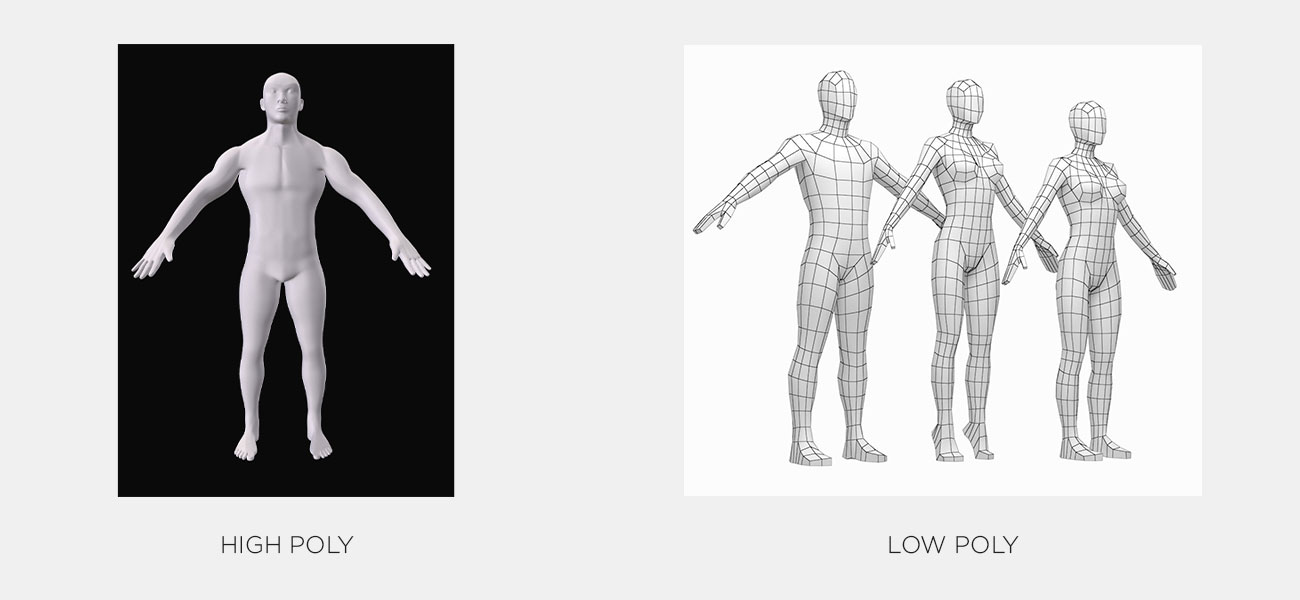 Geometry
GeometryHigh poly- If we talk about the difference between both high poly and low poly on the basis of geometry, then it is not wrong to say that high poly has more complex geometry as compared to the low poly.
This type of polygon modeling consists of many polygons that are of different shapes, especially when a 3D modeler is creating curved objects.
Low poly- As compared to high poly, it has a little less complex geometry with the use of less polygons in the design of the object. This is the reason why low poly is easily adaptable on applications and digital platforms.
-
On the basis of detailing
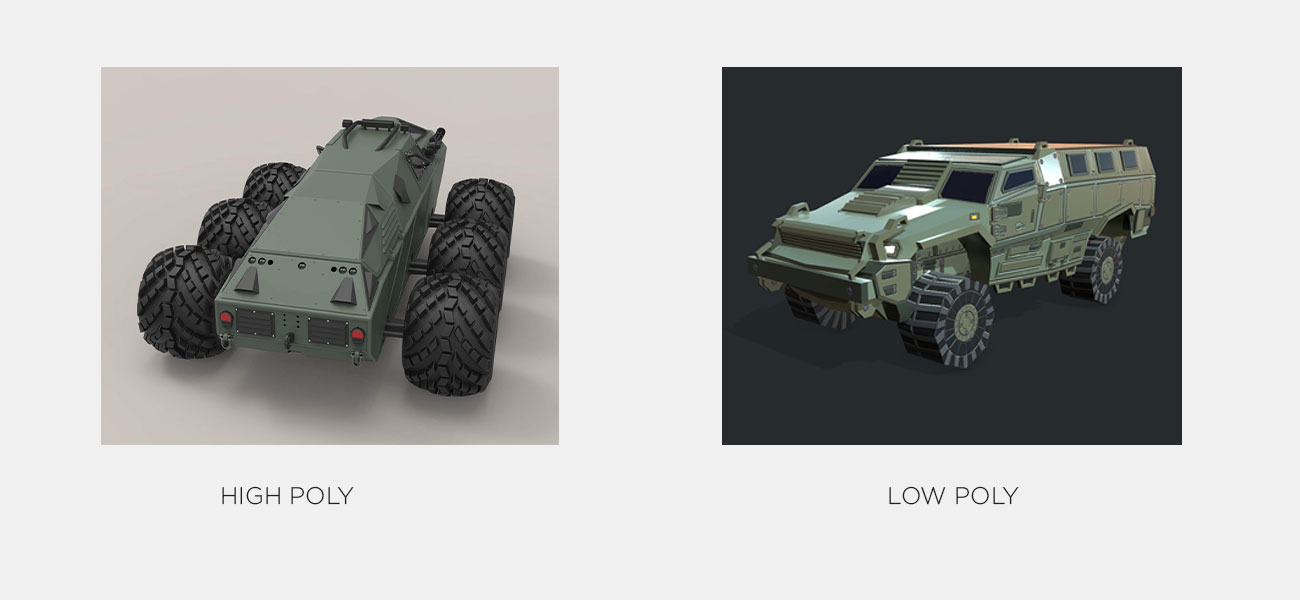 Detailing
DetailingHigh poly- When it comes to detailing, high poly is a well-defined and detailed polygon modeling technique that includes details in terms of intricate design elements, some additional decoration etc.
Low poly- As compared to the high poly, low poly cannot afford to be hyper detailed. The reason is simple, if the details are added to an object that is to be viewed in 360 degree on a digital platform, it will take high load time or may not load due to the large file size.
-
On the basis of static & motion usage
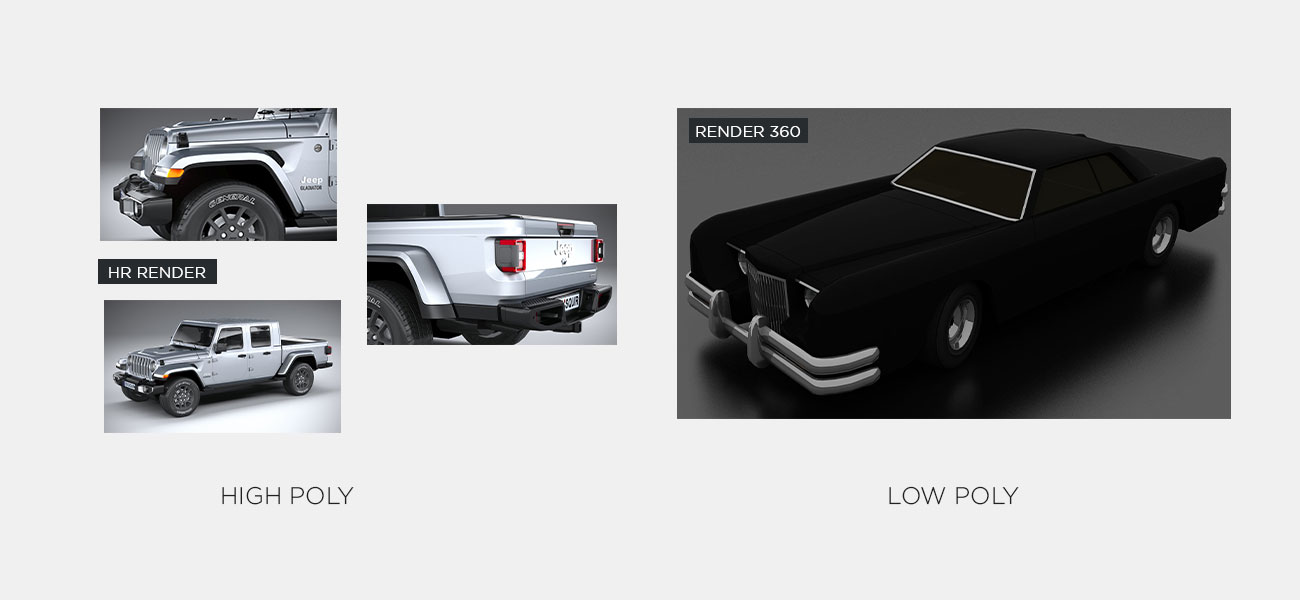 Static & motion
Static & motionHigh poly- This technique works great with static HR renders, the reason is high poly models are very detailed and thus can’t be used for motion purposes.
Low poly- On the contrary to the above, low poly works well with motion CG imagery where a 360 degree view of an object is required.
-
On the basis of texture process
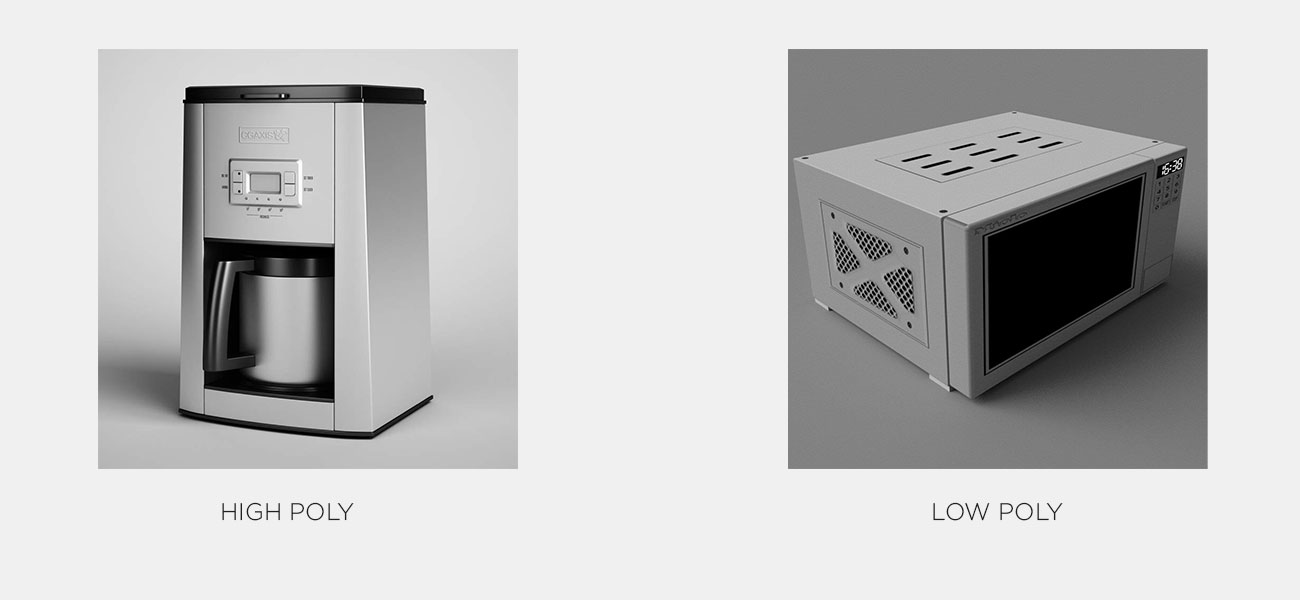 Texture process
Texture processHigh poly- The process of texturing in high poly modeling is a bit tricky. For this, the first and most important thing a 3D modeler requires is a high definition image to get the texturing right. Post that various levels of texturing maps are used for the purpose.
Low poly- However, texturing in low poly modeling is not that tricky. The use of texturing maps is less in this and this is why the rendering is done at ease.
-
On the basis of processing time
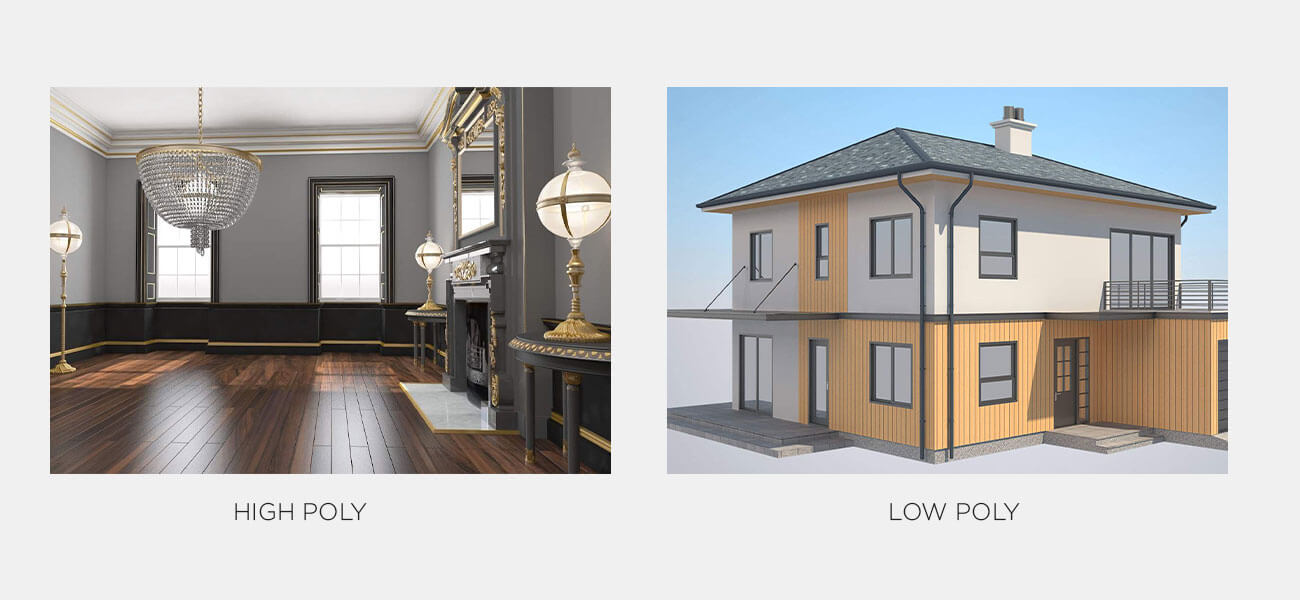 Processing time
Processing timeHigh poly- These models take more time in processing and rendering because of the detailed structuring of various textures, geometrical designs, etc.
Low poly- These can be rendered in very less time and sometimes real-time because of its non-complex designs and less detailed structures.
-
On the basis of realism
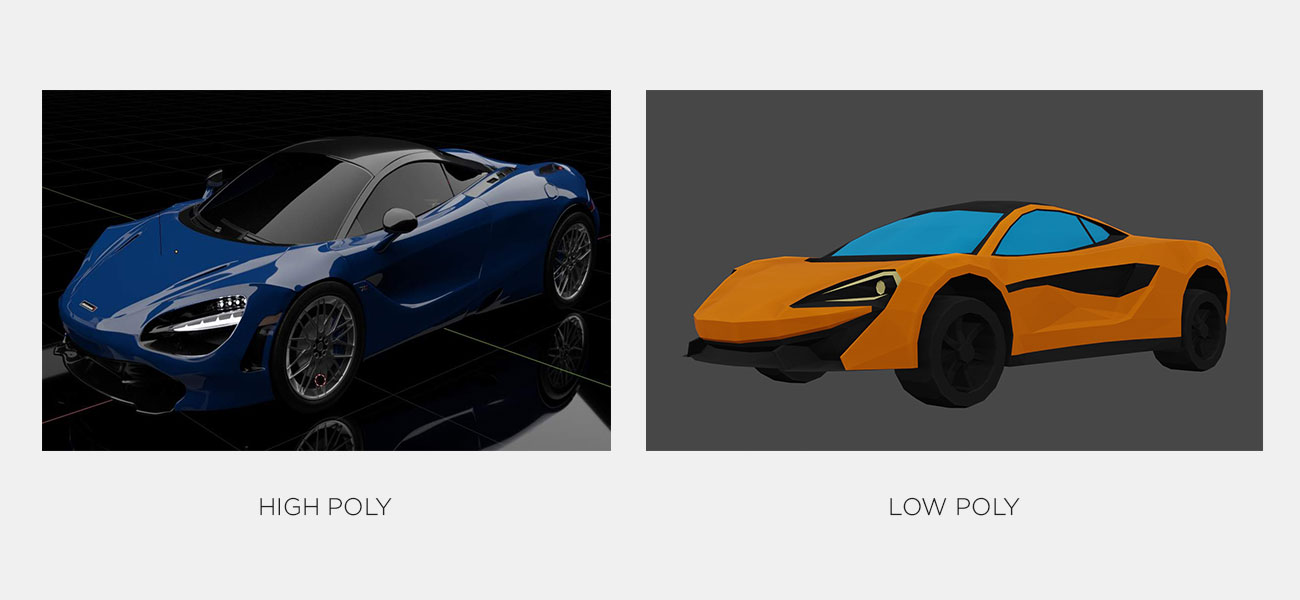 Realism
RealismHigh poly- In this, because of detailed representation of an object the state of realism is high. This means the high poly designs give a more realistic look and feel.
Low poly- This because of less detailed representation, gives less sense of realism as compared to high poly, however it is very close to it but not exactly what a high poly model represents.
Should I Use High or Low Poly 3D Modeling?
Some of the important factors that decide which type of polygons to be used are discussed below:
Type of models
The structure of 3D models is highly dependent on the purpose for which they should be used. If you are looking to create silo renders of static renders that can be used in lifestyle imageries or product promotional cut-outs, then you should go for high-poly models.
High-poly models have high quality and they can let you easily portray your products’ features in a very detailed manner.
Low-poly models are primarily used to create motion graphics that may appear in the form of AR-VR visuals, 3D configurators, 360 degree views, and games. Since these models should function well on gaming and rendering engines they have a low-poly count so that they can get processed by any application quickly.
Object geometry and detailing
High-poly models have a complex geometry and they are made up of several polygons having diverse shapes particularly if you are creating models of curved objects. In other words, complex 3D models feature precise detailing.
3D designers take proper care while creating the object geometry and ensure that they prevent high-poly modeling related errors such as chipping or the appearance of visible seams or holes on the model’s surface. These models feature intricately detailed design elements and so they look photorealistic and exceptional.
Models with a low poly-count have a simpler geometry and this is what makes them compatible with all digital platforms and applications. Low-poly objects do not have a lot of detailing. If your product has too many details and you need a 360 degree view of your product as well, you should ask your 3D artists to perform retopology on a 3D model.
This involves a reduction in the polygon-count in the mesh. If this is not done, the file size will be large and the engine will fail to perform real-time rendering.
Texture quality
Adding textures to high-poly models is a difficult process. 3D artists need to use several texture maps in order to create realistic outcomes.
If you are looking to get high-poly 3D objects created, you should provide your 3D artists with HD images of samples. They can either create a similar texture from scratch or they may even find the same in their existing library.
The textures and materials that are used to create low-poly models are not complex and they can be rendered very easily. Here 3D artists can create textures conserving the visual aspects while still being able to reduce the texture map count.
With this approach, it becomes easier to create realistic yet lightweight models.
Time
High-poly models have complex geometry and so they demand considerable time to be rendered. The process of rendering involves calculation of the light refraction from all the surfaces and edges of the high-poly model. This is a time consuming process and the results are photorealistic.
Reputed 3D modeling studios have their own rendering farms and so they can create 3D objects faster. Low poly models can be created quickly in real time and can be easily processed by various AR-VR applications and game engines.
Conclusion
Every 3D model has a different purpose to serve and hence you decide using low polygon modeling or high polygon modeling based on your project requirement. You may take reference from the above explained scenarios that will help you in figuring out what will work best for your business or related projects.
Or if you have a requirement for a professional 3D modeling service provider, we have a solution.
Need a quote? Write to us or call us for a free quote.
Contact Us

